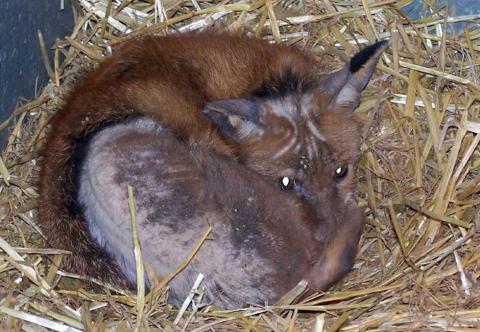Red Fox Parasites & Diseases
Foxes are known to harbour a range of different parasites, both internally and externally, including various species of intestinal worms, flukes, lungworm, heartworm, tick, mite, flea, protozoan, virus, bacteria and fungi. Some of those of greatest concern, owing to them being zoonoses (i.e., can be transferred to humans), include Toxocara canis (dog roundworm), Echinococcus multilocularis (hyatid worm) and Trichinella spiralis (muscle worm). Toxocara is present in the UK, although foxes don't appear to be a significant link in the "infection chain". Echinococcus is currently considered by DEFRA to be absent from Britain, while the last confirmed case of the nematode worm Trichinella in a fox from Britain was in 1957. There is an on-going Trichinella monitoring programme in Britain, carried out by the Food and Environmental Research Agency (FERA).

Angiostrongylus vasorum (canine heartworm) and Sarcoptes scabiei (mange mite) are also important parasites of foxes that can be passed to domestic dogs. In Britain, the average prevalence of the heartworm is about 7% (although locally prevalence can reach almost 30%) and it is widely considered that slugs and snails are a more significant source of infection than foxes. Mange (image, right) can be a significant problem and cause large-scale mortality; the mites can be transferred to domestic dogs, but infection is easily treated using ivermectin or selamectin in non-pregnant animals (for more details see Mange in foxes).
In Bristol, here in the UK, a mange epidemic in the mid-1990s saw some parts of the city lose 98% of their foxes in only a few years. Similarly, in the winter of 1997/98 the first case of sarcoptic mange was recorded in a fox in Nemuro, Japan and the result was an outbreak that saw 85% of inspected foxes infected with the parasite by 1999 -- the population was estimated to have declined from around 300 individuals in 1996 to just 70 in 2000. Interestingly, in Japan, the mange prevalence didn't appear to affect the birth rate, just the natural mortality rate.
Sarcoptes scabiei are probably the most common mite species found on foxes, but they are also susceptible to infection by others, including the ear canker mite Otodectes cynotis, which often presents as bent over (semi-flattened) ears that are frequently scratched at. During their post mortems of 50 foxes killed by hunters during 2010 in the Province of Pisa, central Italy, Stefania Perrucci and colleagues found that 8% were infected with O. cynotis. I'm not aware of any data from the UK, but in 2006 Alica Kočišová and colleagues reported canker mites from two (2.6%) of the 78 foxes they studied in eastern Slovakia, while Tamás Sréter and his team isolated them in two (2%) of the 100 animals they post mortemed from 16 counties of Hungary in 2003. Eggert Gunnarsson has noted how Otodectes mites are sometimes a significant problem on fur farms, although this is likely to be at least partly associated with the density of animals.
Wounded foxes can be susceptible to secondary bacterial infections (notably with Streptococcus) and myiasis (a condition, also known as fly-strike or blowfly, where parasitic flies lay eggs in open wounds and the newly-hatched larvae feed on the tissue), although there is little evidence of gangrene in this species. Possibly the pathogen of greatest concern is rabies, for which the Red fox is the major sylvatic vector (wildlife carrier) in Europe (see Rabies & the Red Fox). The virus is transferred through a bite and can be fatal to both humans and other animals (including foxes); large scale vaccination of foxes has served to control the spread of rabies in recent years, eradicating it altogether from parts of western Europe. Foxes are also capable of carrying bovine tuberculosis (although apparently aren't infectious) and Weil's disease, although they aren't considered significant vectors for either disease. Recent work by biologists at the Royal Veterinary College in London isolated Staphylococcus aureus bacteria, although they didn't find any Methicillin-resistant S. aureus (MRSA).

Some of the most endearing stories of fox cunning revolve around how they remove parasites; most notably how they rid themselves of fleas and lice. Legend has it that foxes rid themselves of lice and/or fleas by holding some wool, or corn silk, grass, bark, etc. in their mouth and walking backwards into water; this causes the fleas to move up the fox's body and onto the object in the mouth, to escape drowning, which the fox then releases, and off it floats with all the fleas. The author Ernest Seton apparently witnessed this behaviour -- he wrote about it in 1929 -- and then analysed the wad of corn silk that the fox had evidently been holding; on it he apparently found lice.
Lloyd, in his book The Red Fox, mentions that Alex Wetmore recorded a similar behaviour by a Grey fox (Urocyon cinereoargenteus) in a 1952 article to the Journal of Mammalogy. Curiously, I cannot see reference to this in the paper; it's entirely about the attraction of a grey fox to a crow call and decoys. Regardless, Lloyd, like many others, had his doubts as to the validity of such accounts:
"The practical objection to the story is that the skin of the fox would not become wet through by this rather gradual immersion, so the fleas would not be in any danger of drowning..."
Despite the improbability of such behaviour, it's an interesting story that has persisted since at least Hellenic times, around 323 BC.
Foxes also present with eye damage and it is not uncommon to find trailcam footage shows a fox with only one eye reflecting back. Foxes have a layer of effulgent cells behind the retina, the tapetum lucidum, that helps improve their nocturnal vision by reflecting light back into the eye; damage can prevent light being correctly returned, resulting in one eye being duller than the other or even completely non-reflective. Such cases are likely to be the result of corneal injury/scarring, easily sustained during fighting or from incidental damage by vegetation. Cataracts are occasionally reported and Charlotte Lempp and her colleagues found one in each of two foxes in their sample from urban areas of Schleswig-Holstein in Germany. In my experience, foxes seem to cope with damage to a single eye without too much trouble, although could theoretically affect their hunting by compromising their depth perception.

Very occasionally, foxes present at wildlife rescues with a swollen muzzle with a slight protrusion of the tongue. Closer inspection reveals swelling of the gums; a condition known as hyperplasic gingivitis. I'm aware of only a handful of reports of this condition from wild foxes in the UK, most recently a dog fox taken to a rescue in north-west England in 2020, although there are some reports in the literature of this condition among farmed foxes. More generally in terms of dentition, worn, broken, or missing teeth are not vastly uncommon. In their 2025 paper to Mammal Research, for example, Karin Alström and co-workers reported on the dental profiles of 55 free-ranging foxes from southern and western Sweden. Nearly 6% of fox teeth they examined had uncomplicated crown fractures, while just over 6% showed signs of attrition and/or abrasion, both of which impact the fox's ability to hunt. 17 (31%) of the foxes had missing teeth.
Finally, farmed (ranched) foxes are known to be susceptible to dilated (sometimes also called "congested") cardiomyopathy, a condition under which the heart chambers become enlarged, stretching and thinning the muscle and reducing the heart's ability to pump blood. Studies suggest that this disorder may be the result of a taurine (2-aminoethanesulfonic acid) deficiency in the fox's diet. Indeed, in a paper to the American Heart Journal published during February 1991, a team at Cornell University reported that nearly half of the 68 foxes they echocardiogrammed from one farm exhibited signs of dilated cardiomyopathy (DCM) and that the plasma taurine concentrations were significantly lower in these animals than healthy ones (27 nmol/ml vs. 99 nmol/ml). Of particular note was that cysteinesulfinic acid decarboxylase activity (part of the pathway to making taurine) was also much lower in affected foxes than in healthy ones and this was most obvious among younger foxes (i.e., <9 months old), further suggesting that some foxes lack the ability to make taurine as is well known among cats.
The observation that some farm foxes appeared unable to produce taurine led some welfare organisations to suggest people feeding foxes should provide cat food, which is required to contain taurine, or only provide red meat; hence, that just providing dog food may cause heart problems in foxes. While we do now have some evidence linking DCM to taurine deficiency in certain breeds of domestic dog (e.g., golden retrievers, cocker spaniels and Saint Bernards), subsequent studies of farmed foxes presenting with CDM have failed to find the same correlation. Indeed, in a 2007 paper to Revue de médecine vétérinaire, Pablo Martino and colleagues suggest that Escherichia coli bacteria may be involved in the disorder.
A more thorough discussion of the parasites and diseases known from the Red fox can be found in the associated QA.